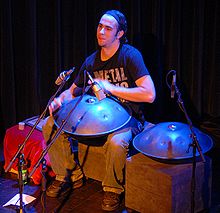The Hang (German pronunciation: [haŋ], plural form: Hanghang[) is a musical instrument in the idiophone class created by Felix Rohner and Sabina Schärer in Bern, Switzerland. The name of their company is PANArt Hangbau AG.The Hang is sometimes referred to as a hang drum, but the inventors consider this a misnomer and strongly discourage its use.
The instrument is constructed from two half-shells of deep drawn, nitrided steel sheet glued together at the rim leaving the inside hollow and creating a distinct 'UFO shape'. The top ("Ding") side has a center 'note' hammered into it and seven or eight 'tone fields' hammered around the center. The bottom ("Gu") is a plain surface that has a rolled hole in the center with a tuned note that can be created when the rim is struck.
The Hang uses some of the same basic physical principles as a steelpan, but modified in such a way as to act as a Helmholtz resonator.[7] The creation of the Hang was the result of many years of research on the steelpan and other instruments. The inventors of the Hang have continued to refine the shape and materials and have produced several variations over the years.
The name Hang comes from the Bernese German word for hand. It is a registered trademark and property of PANArt Hangbau AG.
Playing the Hang
Manu Delago playing a first generation Hang
The top (Ding) side of the Hang, depending on how it is played, can sound like a harp, bells, or harmonically tuned steelpans. The notes are laid out in a cross pattern in the 'tone circle' from low to high so that with a specific orientation of the Hang, the player can ascend or descend the 'scale' by alternating using the left and right hands to strike the 'tone fields'. Each tone field has multiple overtones oriented specifically in the flattened field with a dome at the center. Typically there is a fundamental tone, an overtone tuned to an octave above that fundamental, and an additional overtone a fifth above that octave (twelfth/tritave). The orientation is fairly consistent across the fields on each Hang so that the overtones can be highlighted, muted, or extracted based on how and where the player strikes the tone field.
The bottom side of the Hang has a round opening, the Gu, producing together with the air in the cavity a Helmholtz resonance similar to a ghatam or an udu. In the 2nd generation, Integral Hang and Free Integral Hang adjustment of the size of the Gu (by partially blocking it with either a hand, or the legs) can generate a sympathetic D2 from the Helmholtz resonance, which introduces subtle layers of cross complexities in the resonance of the instrument as notes are played on the Ding side. In the 1st and 2nd generation models there is a single high note with a long sustain that can be generated by striking the rim of the hole on the 'Gu' side. In the Integral Hang there are two notes that can be generated (F and F#). The Hang can also be used as a friction idiophone. Shaker-like sounds can be made by sliding a hand across the surface, and it can also ring like a singing bowl by using skin (a hand) or a bow.

Free Integral Hang (2010)
|
|
| Percussion instrument | |
|---|---|
| Hornbostel–Sachs classification | 111.24 (Percussion vessels) |
| Inventor(s) | Felix Rohner, Sabina Schärer |
| Developed | 2000 |
| Builders | |
| Felix Rohner, Sabina Schärer | |
Source: https://en.wikipedia.org/wiki/Hang_%28instrument%29

That is just plain cool. Thank you. That was fun.
ReplyDeleteThe longer I listened, the more I liked it! :o)
DeleteInteresting sound. I enjoyed it, Thank You!
ReplyDeleteYou're welcome, Brighid! Lots of videos out there of different people playing it.
Delete